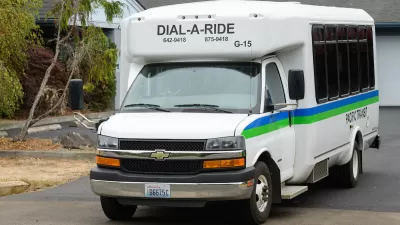Minnesota’s on-demand microtransit service is helping connect residents to fixed-route service and daily needs.

Some transit services that are including on-demand services are seeing bigger increases in ridership, according to an article in the Minnesota Reformer, as post-pandemic travel patterns shift away from the typical 9-to-5 commutes.
In Minnesota, the Minnesota Valley Transit’s Connect service “is so popular that it’s having trouble keeping up with demand, even as the Legislature allocated over $9 million last year to build out Connect and similar systems statewide.”
Unlike other dial-a-ride services, Connect and other microtransit options offer service within an hour or less. It also lets passengers board without a reservation when the bus stops to pick up someone else.
Microtransit options can work well in less-dense areas and suburbs where few other transit options are available and where ridership is sparse. However, the per-mile cost of these services can be prohibitive to some agencies and, some have argued, does not scale well. For example, “To manage demand, MVTA only allows riders to book rides up to three hours ahead of time, while also cutting some regular bus service in September to ensure they have enough drivers to provide the service in their existing areas.”
FULL STORY: Local transit agencies mimicking Uber and Lyft are seeing big ridership gains

Manufactured Crisis: Losing the Nation’s Largest Source of Unsubsidized Affordable Housing
Manufactured housing communities have long been an affordable housing option for millions of people living in the U.S., but that affordability is disappearing rapidly. How did we get here?

Americans May Be Stuck — But Why?
Americans are moving a lot less than they once did, and that is a problem. While Yoni Applebaum, in his highly-publicized article Stuck, gets the reasons badly wrong, it's still important to ask: why are we moving so much less than before?

Using Old Oil and Gas Wells for Green Energy Storage
Penn State researchers have found that repurposing abandoned oil and gas wells for geothermal-assisted compressed-air energy storage can boost efficiency, reduce environmental risks, and support clean energy and job transitions.

Updating LA’s Tree Rules Could Bring More Shade to Underserved Neighborhoods
A new USC study finds that relaxing Los Angeles’ outdated tree planting guidelines could significantly expand urban tree canopy and reduce shade disparities in lower-income neighborhoods, though infrastructure investments are also needed.

California's Canal Solar Projects Aim to Conserve Resources and Expand Clean Energy
California’s Project Nexus has begun generating electricity from solar panels installed over irrigation canals, with researchers and state agencies exploring statewide expansion to conserve water and boost clean energy production.

HHS Staff Cuts Gut Energy Assistance Program
The full staff of a federal program that distributes heating and cooling assistance for low-income families was laid off, jeopardizing the program’s operations.
Urban Design for Planners 1: Software Tools
This six-course series explores essential urban design concepts using open source software and equips planners with the tools they need to participate fully in the urban design process.
Planning for Universal Design
Learn the tools for implementing Universal Design in planning regulations.
Heyer Gruel & Associates PA
City of Moreno Valley
Institute for Housing and Urban Development Studies (IHS)
City of Grandview
Harvard GSD Executive Education
Salt Lake City
NYU Wagner Graduate School of Public Service
City of Cambridge, Maryland





























